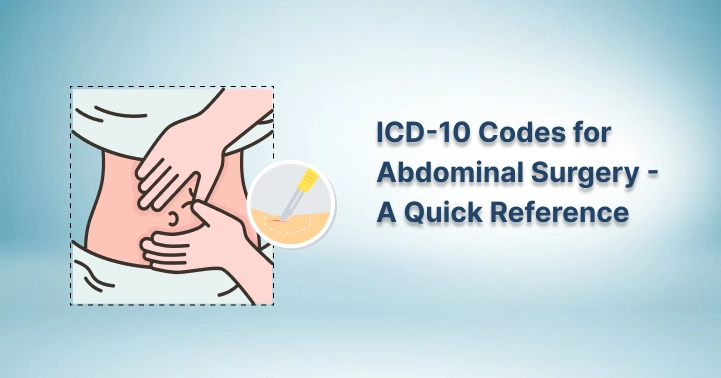Abdominal pain is a common symptom documented across healthcare facilities worldwide. Accurate coding of abdominal pain is crucial for ensuring proper documentation, claims submission, and insurance reimbursement. The ICD-10 system offers a variety of codes to classify different types and causes of abdominal pain, allowing healthcare providers to document patient conditions with precision. We will add details about abdominal pain ICD 10 codes, including common categories, specific scenarios, and best practices for coders to ensure they stay updated about latest classification of the disease.

1. Understanding Abdominal Pain and Its ICD-10 Classification
What is Abdominal Pain?
Abdominal pain refers to discomfort or a painful sensation in the region between the chest and the pelvis. It can arise from multiple organs, including the stomach, intestines, liver, pancreas, kidneys, or reproductive organs. The severity and location of the pain often guide the diagnosis and treatment.
ICD-10 Codes for Abdominal Pain
The ICD-10 system classifies abdominal pain under R10 (Abdominal and pelvic pain), which is part of the broader category R00-R99: Symptoms, signs, and abnormal clinical and laboratory findings, not elsewhere classified.
Key subcategories include:
- R10.0: Acute abdomen (severe abdominal pain requiring emergency evaluation).
- R10.1: Pain localized to upper abdomen (including epigastric pain).
- R10.2: Pain localized to lower abdomen.
- R10.3: Pain localized to other parts of the abdomen.
- R10.4: Other and unspecified abdominal pain.
- R10.84: Generalized abdominal pain.
- R10.9: Unspecified abdominal pain.
Each code provides specific diagnostic clarity, aiding healthcare providers in documenting and treating patients effectively.
2. Common ICD-10 Codes for Abdominal Pain and Their Uses
R10.0 – Acute Abdomen
This code is used for sudden, severe abdominal pain that often indicates a surgical emergency, such as appendicitis, bowel perforation, or ectopic pregnancy.
R10.1 – Pain Localized to Upper Abdomen
- Subcategory R10.11: Right upper quadrant pain (e.g., gallstones, liver abscess).
- Subcategory R10.12: Left upper quadrant pain (e.g., splenic rupture or abscess).
- Subcategory R10.13: Epigastric pain (often associated with gastritis or ulcers).
R10.2 – Pain Localized to Lower Abdomen
- Subcategory R10.31: Right lower quadrant pain (classic for appendicitis).
- Subcategory R10.32: Left lower quadrant pain (common in diverticulitis).
R10.4 – Other and Unspecified Abdominal Pain
- R10.84: Generalized abdominal pain, often seen in conditions like irritable bowel syndrome (IBS).
- R10.9: Unspecified abdominal pain, used when the origin or cause is unclear.
3. Clinical Considerations and Documentation Tips
1. Importance of Detailed Documentation
Accurate documentation of abdominal pain’s location, severity, and associated symptoms is critical for selecting the appropriate ICD-10 code. For example:
- Include anatomical details: Specify if the pain is in the upper, lower, right, or left quadrant.
- Describe the pain’s nature: Is it sharp, dull, cramping, or radiating?
- Note associated symptoms: Include fever, vomiting, or changes in bowel habits.
2. Avoiding Common Coding Errors
- Using unspecified codes (e.g., R10.9): Only use these when absolutely necessary. Coders should strive to utilize specific codes like R10.11 or R10.31 whenever possible.
- Misclassification: Ensure that the pain’s location matches the documented anatomical quadrant (e.g., right flank pain should not be coded as upper abdominal pain).
4. Diagnosing Abdominal Pain: Key Scenarios and Their Codes
1. Acute Appendicitis
- Primary Code: K35.80 (Acute appendicitis without perforation or gangrene).
- Accompanying symptoms like localized right lower quadrant pain (R10.31) can also be documented.
2. Irritable Bowel Syndrome (IBS)
- Primary Code: K58.0 (IBS with diarrhea) or K58.9 (IBS without diarrhea).
- Generalized abdominal pain: R10.84.
3. Gastroenteritis
- Primary Code: A09 (Infectious gastroenteritis and colitis, unspecified).
- Accompanying epigastric pain: R10.13.
5. Best Practices for Accurate ICD-10 Coding of Abdominal Pain
1. Follow Official Coding Guidelines
ICD-10-CM coding guidelines emphasize the importance of coding symptoms when a definitive diagnosis hasn’t been established. For abdominal pain:
- Primary Diagnosis: Use specific codes for the abdominal pain if no underlying condition is confirmed.
- Secondary Diagnosis: When abdominal pain is a symptom of a confirmed condition (e.g., appendicitis or diverticulitis), code the primary condition first, followed by the appropriate pain code.
2. Collaborate with Physicians
Coders should work closely with healthcare providers to ensure accurate documentation:
- Encourage providers to describe the type, location, and duration of pain.
- Request clarification for ambiguous terms like “belly pain” or “stomachache,” which may lead to the use of nonspecific codes.
3. Use Technology for Precision
Leverage coding software and electronic health record (EHR) systems to streamline the coding process. Features like natural language processing (NLP) can help identify keywords and map them to the correct ICD-10 code.
4. Audit Regularly
Regular audits help identify coding inconsistencies and areas for improvement. Pay particular attention to:
- Overuse of unspecified codes like R10.9.
- Missed opportunities to document secondary conditions contributing to the pain.
5. Stay Updated
ICD-10 codes are updated annually, and new clinical conditions may influence coding practices. For example, the 2025 updates to R10.84 (generalized abdominal pain) highlight the importance of differentiating it from R10.0 (acute abdomen).
6. Special Scenarios in Abdominal Pain Coding
1. Pediatric Abdominal Pain
Abdominal pain in children often presents diagnostic challenges. Common ICD-10 codes include:
- R10.83: Colic in infants.
- K52.9: Noninfective gastroenteritis and colitis, unspecified.
For cases where abdominal pain is associated with vomiting or diarrhea, include:
- R11.10: Vomiting, unspecified.
- R19.7: Diarrhea, unspecified.
2. Chronic Abdominal Pain
When pain persists for more than 3–6 months, it may be classified as chronic:
- R10.11: Upper quadrant chronic pain.
- R10.31: Lower quadrant chronic pain.
If the pain is associated with functional conditions like IBS or functional dyspepsia, the coding must reflect the underlying condition.
3. Abdominal Pain During Pregnancy
Pregnant patients with abdominal pain require special coding considerations:
- O26.89: Other specified pregnancy-related conditions.
- R10.2: Lower abdominal pain (often due to ligament stretching or early labor).
Ensure that codes for pregnancy trimester (e.g., Z3A.00 for the first trimester) are included to provide a complete clinical picture.
4. Postoperative Abdominal Pain
Post-surgical abdominal pain can signal complications such as infections or adhesions:
- K91.89: Other postprocedural complications and disorders of the digestive system.
- Use pain codes (e.g., R10.13 for epigastric pain) as secondary codes to document the symptom.
7. Frequently Asked Questions (FAQs)
When should I use R10.9 (Unspecified abdominal pain)?
Use R10.9 only when the medical record lacks sufficient detail to classify the pain. If specific information about the location (e.g., upper quadrant) or type (e.g., generalized) is available, opt for a more precise code.
Can I code abdominal pain alongside a confirmed diagnosis?
Yes, abdominal pain can be coded as a secondary diagnosis when it is a prominent symptom of a primary condition, such as K35.80 (Acute appendicitis without perforation).
How should I code flank pain?
Flank pain is often coded under the abdominal pain category:
- Use R10.2 for lower abdominal pain if the documentation supports it.
- If flank pain is related to kidney issues, use codes like N23 (Renal colic).
What are the documentation requirements for generalized abdominal pain (R10.84)?
Physicians must specify:
- The duration of the pain (acute or chronic).
- Associated symptoms (e.g., fever, nausea).
- Whether diagnostic investigations (e.g., CT scan, blood tests) have been performed.
8. Coding for Abdominal Pain in Claims Submission
1. Linking Pain Codes to Diagnostic Tests
To justify diagnostic procedures like ultrasounds or CT scans, include the appropriate pain code as the primary reason for the service:
- R10.13: Epigastric pain for suspected ulcers.
- R10.31: Lower quadrant pain for suspected appendicitis.
2. Reimbursement Tips
- Ensure that all pain-related codes align with the documented reason for the encounter.
- Check payer-specific guidelines, as some insurers may deny claims with unspecified codes like R10.9 unless substantiated by supporting documentation.
3. Use of Modifiers
Modifiers like -25 (significant, separately identifiable E/M service) may be required when coding abdominal pain alongside procedural codes.
Conclusion
Coding for abdominal pain requires a thorough understanding of ICD-10 classifications, clinical contexts, and documentation requirements. By using the appropriate codes and adhering to best practices, healthcare providers and coders can ensure accurate documentation and reimbursement.
Whether you’re handling acute abdominal emergencies, chronic conditions, or complex postoperative cases, mastering abdominal pain coding can significantly enhance your medical billing accuracy and compliance.
QZ Medx is your go-to medical billing solutions providing company. Contact us today!




